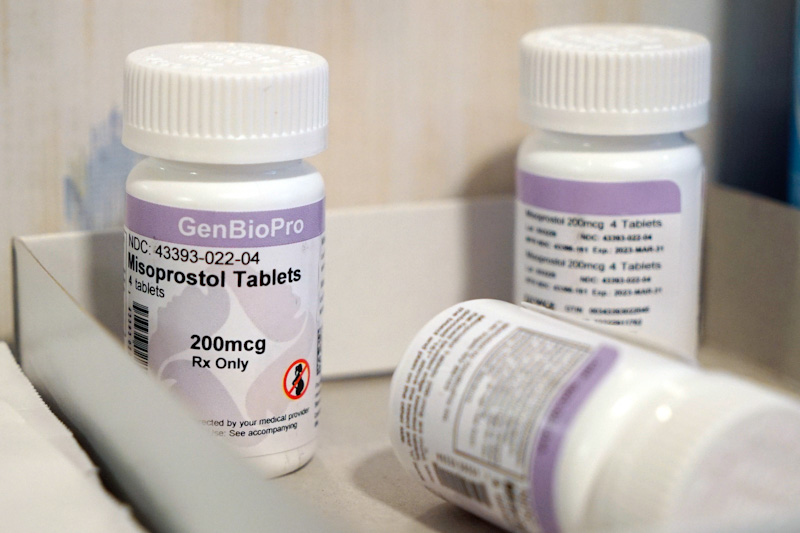Supreme Court revisits abortion debate in case over access to pregnancy-ending drug

Boxes of the drug mifepristone sit on a shelf at the West Alabama Women's Center in Tuscaloosa, Alabama, on March 16, 2022. The drug was approved by the Food and Drug Administration in 2000. (Photos by Allen G. Breed/The Associated Press)
When the U.S. Supreme Court ended nearly 50 years of the federal constitutional right of women to terminate their pregnancies in its 2022 Dobbs v. Jackson Women’s Health Organization decision, the majority said it was time to “return the issue of abortion to the people’s elected representatives.”
While a few states seek to bolster protections for abortion, others are continuing to debate limits and the procedure is now banned or restricted in at least 20 states. But nationwide, abortions increased last year and the use of prescription medicines to terminate pregnancies rose from 53 percent of all abortions in 2020 to 63 percent in 2023, according to a report released March 19 by the Guttmacher Institute, a research organization that supports abortion rights.
Next week, a case about federal regulation of the primary drug used in medication abortions will be taken up by the justices, returning a major issue in the abortion debate to them perhaps sooner than they would have wished.
In Food and Drug Administration v. Alliance for Hippocratic Medicine, the court could decide whether the FDA’s 2016 and 2021 actions easing access to and the conditions of use of mifepristone were proper under federal administrative law.
“The majority of abortions in this country now occur with medication,” says Greer Donley, an associate dean at the University of Pittsburgh School of Law and a scholar of U.S. abortion law (who joined an amicus brief in support of the FDA). “When you have a court potentially disrupting the regulatory scheme for the way a majority of people are accessing abortion, that is going to have a huge impact.”
 Related article from ABAJournal.com: “Can court ban abortion pill? Federal judge considers authority, plaintiffs’ standing”
Related article from ABAJournal.com: “Can court ban abortion pill? Federal judge considers authority, plaintiffs’ standing”
FDA change opens access by mail
The FDA approved mifepristone in 2000 to terminate a pregnancy, initially within a gestational age of seven weeks. The drug was approved for use in a regimen with another drug, misoprostol, which is approved for other uses and is not challenged in this case. The original conditions of use for mifepristone required women to be dispensed the drug in-person in consultation with a doctor, and they generally required three clinical visits: one to take mifepristone; the second two later to take misoprostol; and a third about two weeks later to confirm the end of the pregnancy.
In 2016, the FDA approved an application from mifepristone’s manufacturer, Danco Laboratories Inc., to ease the conditions of use to lower the dose of the drug; increase the gestational age limit to 10 weeks; reduce the required clinical visits to two; and to modify the regulatory framework for the drug to allow certain nonphysician health care providers, such as nurse practitioners, to prescribe the medication. The agency found at that time that adverse events from taking the drug were “exceedingly rare,” and were comparable to the same rate of adverse events following surgical abortions.
In 2020, amid the COVID-19 pandemic, a court ordered the FDA to stop requiring that mifepristone be dispensed in person. Although the Supreme Court blocked that lower court order, the FDA went on in 2021 to begin a process that eliminated the in-person dispensing requirement altogether. This led to a major shift to telehealth consultations and the dispensation of the abortion medications by mail or other delivery services.
Marsha Henderson, a former associate commissioner for women’s health at the FDA, says mifepristone “has been regulated more strictly and studied more intensely than most other drugs. We’re talking about hundreds of clinical studies involving tens of thousands of study participants.”
The drug is extremely safe, says Henderson, who retired from the agency in 2019 and is not involved in the case.
A federal judge in Texas blocks access
In 2022, several small doctor’s organizations and individual physicians with moral objections to abortion filed a lawsuit challenging the FDA’s actions on mifepristone, including its 2000 approval of the drug, and the 2016 and 2021 changes to its conditions of use. They argued that the agency ignored significant safety risks in its initial approval and its later changes.
The plaintiffs chose to file their suit in the U.S. district court in Amarillo, Texas, where it was likely to, and did, come before the only resident district judge, Matthew J. Kacsmaryk. The appointee of President Donald Trump has ruled on several lawsuits filed in his court by the state of Texas (on federal immigration policy) and conservative litigants.
In the mifepristone case, Kacsmaryk granted a preliminary injunction that blocked the 2000 approval and the later changes, ruling that they were arbitrary and capricious under the Administrative Procedure Act. He went on to hold that federal statutory provisions that evolved from the Comstock Act of 1873 (which was originally aimed at the mailing of obscenity as well as contraceptives and abortion aids) prohibited the FDA from removing its in-person requirement for dispensing mifepristone.
While that decision was on appeal to the 5th U.S. Circuit Court of Appeals, the Supreme Court granted a stay of the district judge’s order (after the appeals court had blocked it only with respect to the 2000 approval).
The 5th Circuit later ruled on the merits that the challengers were likely to succeed on their claims that 2016 and 2021 changes in conditions of use were arbitrary and capricious. In partial dissent, Judge James C. Ho said he also would have blocked the 2000 approval and further held that the 2021 change allowing mail order delivery of mifepristone violated the Comstock Act.
In the Supreme Court on March 26, both the U.S. solicitor general, on behalf of the FDA, and Danco Laboratories will argue to overrule the 5th Circuit’s decision.
They focus first on a threshold matter, arguing that the individual physicians and doctors’ groups lack standing.
The challengers “have not identified even a single doctor among their thousands of members who has ever been required to perform an abortion in the decades mifepristone has been on the market,” Solicitor General Elizabeth B. Prelogar says in a brief. “They do not prescribe mifepristone, and FDA’s actions allowing other providers to prescribe the drug do not require them to do or refrain from doing anything.”
James A. Campbell, the chief legal counsel of Alliance Defending Freedom, the conservative legal organization representing the challengers, says in an interview that several of the individual doctors among the plaintiffs have standing because they face the possibility of treating women who have adverse reactions to mifepristone.
“They are the individuals that are working in hospitals that are called in to address the complications that are arising, and are arising in greater number in light of the FDA’s decision to remove these safeguards,” he says.
Drug’s defenders cite experience and science
On the merits, Prelogar argues that the FDA’s 2016 and 2021 changes were lawful.
“FDA’s 2016 changes to mifepristone’s approved conditions of use were supported by an exhaustive review of a record including dozens of scientific studies and decades of safe use of mifepristone by millions of women in the United States and around the world,” she says in a brief, adding that the 2021 decision to eliminate the in-person dispensing requirement was based on experience from the pandemic that it was no longer necessary.
Danco, in a brief, says, “The available record contains no basis to overturn FDA’s considered scientific judgment.”
Campbell, in summarizing the merits arguments of the challengers, says, “The question here is whether the FDA betrayed the women who use these drugs when it removed the safeguards it originally said were necessary.”
About the FDA’s 2016 revisions, he says the agency made major “interrelated changes” that under the APA meant it should have produced more evidence to show the drug would continue to be safe or better explain why it shouldn’t have to produce such evidence.
Regarding the 2021 changes, Campbell says the elimination of the initial in-person visit with a doctor “removed the opportunity for doctors to provide in-person screening to ensure that women aren’t experiencing an ectopic pregnancy and [that] they’re not too far along [in their pregnancies] to take the drug.”
Although the 5th Circuit majority did not rely on the Comstock Act, the challengers raise it before the Supreme Court.
“We’re simply telling the court that an alternative basis to rule for us is to apply the Comstock Act and find that what the FDA did in 2021 in authorizing the mailing of mifepristone was indeed a violation,” Campbell says.
Prelogar says in a brief that the Supreme Court should not consider the Comstock Act argument, but that lower courts have long recognized that the statute’s restrictions “should be interpreted to bar only items intended for unlawful use.”
Henderson, the retired FDA official, says she worries that any ruling for the challengers would not only make access to mifepristone more difficult, it would “cause trauma to the system” of drug regulation, possibly endangering developments on vaccines and regenerative medicines.
“Congress established FDA so scientists, not courts, would be arbiters of drug safety and effectiveness,” she says.
See also:
“Supreme Court will consider whether FDA wrongly expanded access to abortion drug mifepristone”



